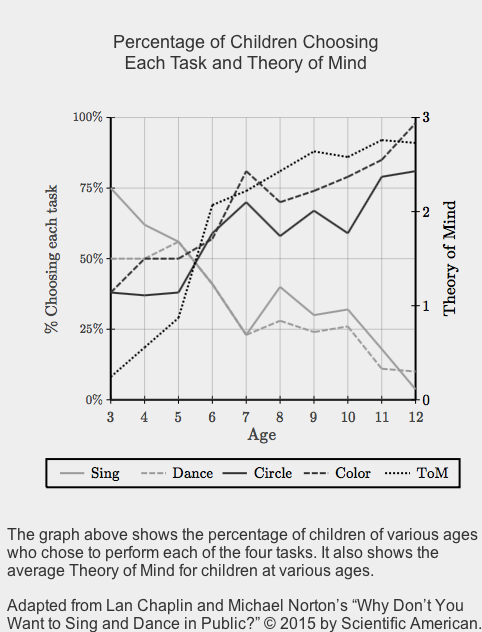Questions 1-5 are based on the following
passage.
This passage is adapted from Lan Chaplin and Michael Norton’s “Why Don’t You Want to Sing and Dance in Public?” © 2015 by Scientific American.
Picture two birthday parties: one for 4 year olds, and one
14 year olds. The former conjures kids bellowing “Happy
Birthday” and putting their left feet in during the “Hokey
Pokey”; the second conjures slump-shouldered teens huddled
5 in corners furtively glancing at each other—even as loud
music blares in the background. Why the difference? Our
research suggests that the process of kids losing the joy of
singing and dancing is intricately linked to a crucial
development in their understanding of other people.
10 We tested the link between the ability to understand the
minds of observers and willingness to perform with a test of
one hundred fifty-nine children ranging in age from 3 to 12
years old. We first gave each child four options in random
order: sing a song of their choosing, perform a dance of their
15 choosing, circle red shapes on a page, or color in a square.
Children had to select two of the four options to complete in
front of us-right then and there. The first two tasks were our
performance tasks, made even more difficult by the fact that
the singing and dancing had to be completed without any
20 musical accompaniment. The second two tasks were our
“control” tasks, which we made deliberately boring to see if
older kids would still choose these over the terror of
performance.
The differences between kids of different ages were
25 surprising even to us. Whereas some 31% of 3-year olds
chose to both sing and dance, not a single child aged 11 or 12
did. Or put another way, while just 6% of 3- and 4-year-olds
chose to avoid both singing and dancing, nearly 75% of 11-
and 12-year olds chose to avoid both.
30 Why such a change in preferences? We next measured
children’s awareness that others might be judging their
performance, using a task that measures “Theory of Mind”-
or our ability to understand that others have minds and
opinions that differ from ours. . . [An] increase in Theory of
35 Mind was strongly and negatively correlated with children’s
desire to sing and dance: the higher children scored on our
Theory of Mind test—the more children understood that
others can have a different opinion of their abilities—the
more likely they are to refuse to perform. And this trend held
40 among our youngest participants: 3- and 4- year olds with a
more developed Theory of Mind were more likely to avoid
singing and dancing.
Our data rule out a salient alternative explanation for our
pattern of performance avoidance, one familiar to anyone
45 interacting with socially awkward teens or tweens: as
children enter puberty they experience a host of changes that
decrease their desire to perform. However, our results show
that the shift away from performance begins as early as age
4-years before children enter puberty-suggesting that these
changes associated with puberty are unlikely to account for
our results.